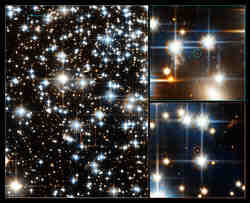Ancient stars can cannibalize to stay young
 Washington, Jan 24: A new research has determined that old stars known as blue stragglers keep the appearance of youth by `cannibalizing' on mass from other stars.
Washington, Jan 24: A new research has determined that old stars known as blue stragglers keep the appearance of youth by `cannibalizing' on mass from other stars.
According to a report in National Geographic News, the research, by Christian Knigge of Southampton University in the U. K. and colleagues, indicate that most blue stragglers are members of binary star pairs that gradually pull matter from their partners.
This cosmic cannibalism allows smaller, aging stars to swell to sunlike proportions, extending their lives by hundreds of millions of years.
According to the study authors, the new finding refutes a leading theory that such rebirths were the results of stellar collisions.
Astronomers have been puzzling over blue stragglers for more than five decades, because the stars are suspiciously young-looking and overweight for their ages.
Most blue stragglers are stars with the same to twice as much mass as our sun.
They are found in globular clusters, which are gravitationally bound groups of roughly a hundred thousand stars that are thought to be about 12 billion years old.
A typical star similar in mass to the sun should live for only a few billion years.
"That means if a given blue straggler formed with the rest of its star cluster, it should have died billions of years ago," Knigge said.
To try and solve the mystery, Knigge and colleague examined blue stragglers in 56 globular clusters.
The researchers have reported a strong link between the total number of blue stragglers and the mass of a cluster's core, the dense central region of stars.
"Cluster cores containing more stars contain more blue stragglers. And the more massive a cluster, the higher number of binary pairs it contains," Knigge said.
"We see a lot of blue stragglers even in massive cores that have low collision rates," he added.
Knigge and his team are now engaged in work to determine whether the binary pairs that tend to form blue stragglers have special life histories, such as close encounters or collisions with other binaries or single stars.
According to Knigge, further observation with tools such as the Hubble Space Telescope should help confirm the team''s findings.
"Determining parameters like spin rates and abundances for a large number of blue stragglers will definitely help unravel their origin," he said. (ANI)